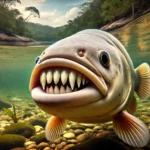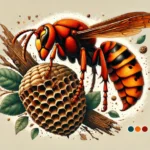The Frilled Shark (Chlamydoselachus anguineus) is one of the most ancient and mysterious creatures lurking in the ocean’s depths. Often referred to as a “living fossil,” this deep-sea predator has remained virtually unchanged for millions of years. With its eel-like body, rows of needle-sharp teeth, and unique hunting abilities, the frilled shark stands out as one of the most bizarre sharks in the world. Let’s explore some fascinating facts about this prehistoric shark species.
1. A Living Fossil from 80 Million Years Ago
The frilled shark is often called a living fossil because it has been around for over 80 million years, surviving the mass extinction events that wiped out the dinosaurs. Fossil evidence suggests that frilled sharks have changed very little since the Cretaceous period, making them one of the oldest species of shark still alive today.
Its primitive appearance and ancient lineage make the frilled shark a valuable species for scientists studying the evolution of sharks and marine life. Its survival through multiple geological periods provides insights into how certain species adapt to deep-sea environments over time.
Key Fact:
- Age: The species dates back 80 million years, making it a living relic of the past.
2. It Looks Like an Eel with Gills
The frilled shark has an eel-like body, making it look quite different from other sharks. Its elongated, slender shape can grow up to 7 feet (2 meters) in length, with a dark brown or grayish color that helps it blend into the deep-sea environment. Unlike most sharks, which have separate gill slits, the frilled shark has six pairs of gills that run along its throat, with frilly edges that give the shark its name.
These frilled gills make the shark look even more primitive, adding to its otherworldly appearance. Its long, snake-like body, combined with the frilled gills and sharp teeth, makes it seem more like a creature from ancient oceans than a modern shark.
Appearance:
- Eel-like body: Long and slender, reaching up to 7 feet.
- Frilled gills: Six pairs of gills with frilly edges, unique among sharks.
- Color: Dark brown or gray for deep-sea camouflage.
3. Rows of Needle-Sharp Teeth
One of the most terrifying features of the frilled shark is its mouth full of needle-sharp teeth. The shark has about 300 teeth arranged in 25 rows, each tooth shaped like a trident with three prongs. These backward-facing teeth are perfect for gripping slippery prey like squid, fish, and smaller sharks.
The teeth are designed to prevent prey from escaping once caught, and the frilled shark’s flexible jaw allows it to swallow prey whole. Its teeth are one of the main reasons why the frilled shark has remained a successful predator for millions of years, helping it thrive in the dark, cold depths of the ocean.
Teeth:
- 300 teeth: Arranged in 25 rows, each with three sharp prongs.
- Purpose: Ideal for trapping slippery prey like squid and fish.
- Flexible jaw: Allows the shark to swallow prey whole.
4. Ambush Predator of the Deep Sea
The frilled shark is an ambush predator, relying on stealth and patience to catch its prey. Living in the deep ocean—often at depths between 400 to 4,200 feet (120 to 1,280 meters)—it hunts in an environment with little light and pressure that would crush most sea creatures. It is thought to use its eel-like body to glide through the water with minimal movement, waiting for prey to come close before lunging forward with its powerful jaws.
Due to the scarcity of food in the deep sea, frilled sharks are opportunistic feeders. They will eat a wide range of prey, including cephalopods (squid), fish, and smaller sharks. Their slow, stealthy approach allows them to ambush prey without being detected.
Hunting Style:
- Ambush predator: Waits for prey to come close before striking.
- Deep-sea habitat: Lives at depths of 400 to 4,200 feet, where light is scarce.
- Opportunistic feeder: Eats squid, fish, and smaller sharks.
5. Unusual Reproductive Cycle
The reproductive cycle of the frilled shark is one of the longest among any vertebrates. Female frilled sharks give birth to live young, but instead of laying eggs, the embryos develop inside the mother’s body. The gestation period is estimated to last up to 3.5 years, which is one of the longest of any shark species.
Once fully developed, the mother gives birth to a litter of 2 to 15 pups, each about 1.5 to 2 feet long at birth. The long gestation period is likely an adaptation to the harsh conditions of the deep sea, where food is scarce, and young sharks need to be born fully developed to survive.
Reproduction:
- Live birth: Embryos develop inside the mother, not in eggs.
- Gestation: Extremely long, lasting up to 3.5 years.
- Litter size: 2 to 15 pups, born fully developed and ready to survive.
6. Rarely Seen by Humans
Due to its preference for deep, dark waters, the frilled shark is rarely seen by humans. It inhabits some of the least explored regions of the ocean, where pressure is high, and sunlight doesn’t reach. Most of what scientists know about the frilled shark comes from specimens accidentally caught in deep-sea fishing nets or those washed up on shore.
However, in recent years, a few frilled sharks have been captured on video by deep-sea submersibles, offering a rare glimpse into the lives of these ancient creatures in their natural habitat. These sightings confirm that the frilled shark is one of the least studied and most mysterious sharks in the world.
Human Interaction:
- Rarely seen: Lives in deep waters, away from human contact.
- Accidental captures: Most sightings are from deep-sea fishing or scientific expeditions.
- Recent video: Occasionally captured on film by submersibles.
7. Named After Its Frilled Gills
The frilled shark gets its name from the frilled edges of its gills, which are unlike the gills of any other shark. Most sharks have five gill slits, but the frilled shark has six pairs, with the first pair extending across its throat like a collar. These gills give the shark a “frilled” appearance, which, combined with its other primitive features, contributes to its ancient and otherworldly look.
The frilled gills are one of the reasons this shark is considered a living fossil, as this feature is more commonly found in prehistoric shark species.
Naming:
- Frilled gills: Six pairs of gills with frilled edges, unique to this species.
- Primitive feature: Resembles ancient sharks, contributing to its “living fossil” status.
8. Possible Inspiration for Sea Serpent Legends
With its long, snake-like body and fearsome teeth, the frilled shark is thought to have inspired ancient sea serpent legends. Sailors who encountered the frilled shark or saw its remains may have mistaken it for a serpent or dragon of the deep. Its unusual appearance and rarity only added to the mystery surrounding it.
Given that the frilled shark rarely comes to the surface, any sightings of it would have been few and far between, further fueling the myth of sea monsters in the minds of early sailors.
Myth and Legend:
- Sea serpent inspiration: Likely contributed to sea monster myths.
- Snake-like appearance: Resembles legendary sea serpents and dragons.
- Rarity: Few sightings have added to its mysterious reputation.
Conclusion
The frilled shark is one of the most unique and ancient creatures in the ocean, with a long evolutionary history that dates back millions of years. From its eel-like body and frilled gills to its fearsome teeth and ambush hunting style, the frilled shark is truly a living relic from a time long past. As one of the least studied sharks, it remains an enigmatic and fascinating species that continues to captivate scientists and deep-sea enthusiasts alike.
FAQ
How old is the frilled shark species?
The frilled shark species is estimated to be over 80 million years old, making it one of the oldest living species of shark.
Why is the frilled shark called a “living fossil”?
The frilled shark is referred to as a “living fossil” because it has changed very little over millions of years and retains many primitive features found in ancient sharks.
How big do frilled sharks get?
Frilled sharks can grow up to 7 feet (2 meters) in length.
What do frilled sharks eat?
Frilled sharks primarily eat squid, but they also consume fish and smaller sharks, using their sharp, needle-like teeth to catch prey.
Where do frilled sharks live?
Frilled sharks inhabit the deep sea, typically at depths between 400 and 4,200 feet (120 to 1,280 meters), in both the Atlantic and Pacific Oceans.
Are frilled sharks dangerous to humans?
Frilled sharks are not considered dangerous to humans. They live in the deep sea, far from human activity, and rarely come into contact with people.


